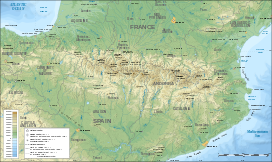geo.wikisort.org - Mountains
Mont Valier (Languedocien: Mont Valièr) (2,838 m) is a mountain of the Pyrenees in Ariège, France.
| Mont Valier | |
|---|---|
 Mont Valier seen from the Port d'Aula | |
| Highest point | |
| Elevation | 2,838 m (9,311 ft)[1] |
| Coordinates | 42°47′52″N 01°05′08″E |
| Geography | |
 Mont Valier Location in the Pyrenees | |
| Location | Ariège, France |
| Parent range | Pyrenees |
| Climbing | |
| Easiest route | By the Ribérot valley and the refuge des Estagnous |
Its name comes from Valerius (Saint Valier, ca. 452), the mythical first bishop of Couserans,[2] who climbed the peak. Bernard de Marmiesse, another bishop of Couserans, had a marble cross erected on the peak in 1670.[3]
Geography

A small glacier, the Glacier d'Arcouzan, occupies its northeastern slope. It is the only glacier in the Pyrenees situated below 3000m, the most Eastern glacier in the chain and also the most isolated. The summit is located on the perimeter of the regional park of the Ariège Pyrenees.
A number of valleys originate on its sides:
On the French side, the stream of Artigues, a tributary of the Salat (which itself rises a few miles from Mont Valier) and the Ribérot, a tributary of the Lez, itself a tributary of the Salat.
On the Spanish side, the Noguera Pallaresa, and a few miles to the west, one of many sources of the Garonne.
Climbing
The normal route, in summer, starts from the Refuge des Estagnous and travels to the Col Faustin before ascending the broad South face. This is the easiest route, although it is still challenging. The other principal route to the summit is via the Arête des Antiques and involves rock climbing along an exposed ridge. The east face and its famous "Trou Noir", (black hole), first climbed by Louis Audoubert in 1971, is rarely ascended.[citation needed] The classic ascent in winter is via the Couloir Faustin; it is a long outing mostly on snow (AD).
History
During World War II, an escape route from Saint-Girons to Esterri d'Àneu in Catalonia crossed Mont Valier. The "Path to Freedom" – the name given in 1994 to the hiking trail that follows the course – enabled the evacuation of 782 people between 1940 and 1944 and remained operational despite increased surveillance by the Germans from 1943. The route was operational until the end of the war.
Protected zone
By a ministerial decree of 5 July 2005, a large area centred on the village of Seix, including the Crown Reserve of Mont Valier, was designated as a "special protection area" and a site of the Natura 2000 network.
References
- IGN at 1:25000 scale on Géoportail
- A. Bourneton, "Une ascension inédite sous le premier Empire", Pyrénées, no. 183-184, 1995, pp. 295-312 ; no. 185, 1996, pp. 16-28 ; no. 186, 1996, pp. 123-133
- Giles Barber, Saint-Girons - Ses rues, leur histoire à travers les âges, PyréGraph, 2005. ISBN 2-908723-64-6.
На других языках
[de] Mont Valier
Der Mont Valier ist ein maximal 2838 m hoher Bergstock im Süden des Départements Ariège in den Zentralpyrenäen im Süden Frankreichs. Er ist nach dem halb legendären Bischof Valerius benannt, der im 5. Jahrhundert den Berg bestiegen haben soll.- [en] Mont Valier
[fr] Mont Valier
Le mont Valier est un sommet de 2 838 m situé dans les Pyrénées ariégeoises, emblématique du Couserans, dominant la vallée d’Angouls et son torrent, à faible distance de la frontière espagnole.Другой контент может иметь иную лицензию. Перед использованием материалов сайта WikiSort.org внимательно изучите правила лицензирования конкретных элементов наполнения сайта.
WikiSort.org - проект по пересортировке и дополнению контента Википедии